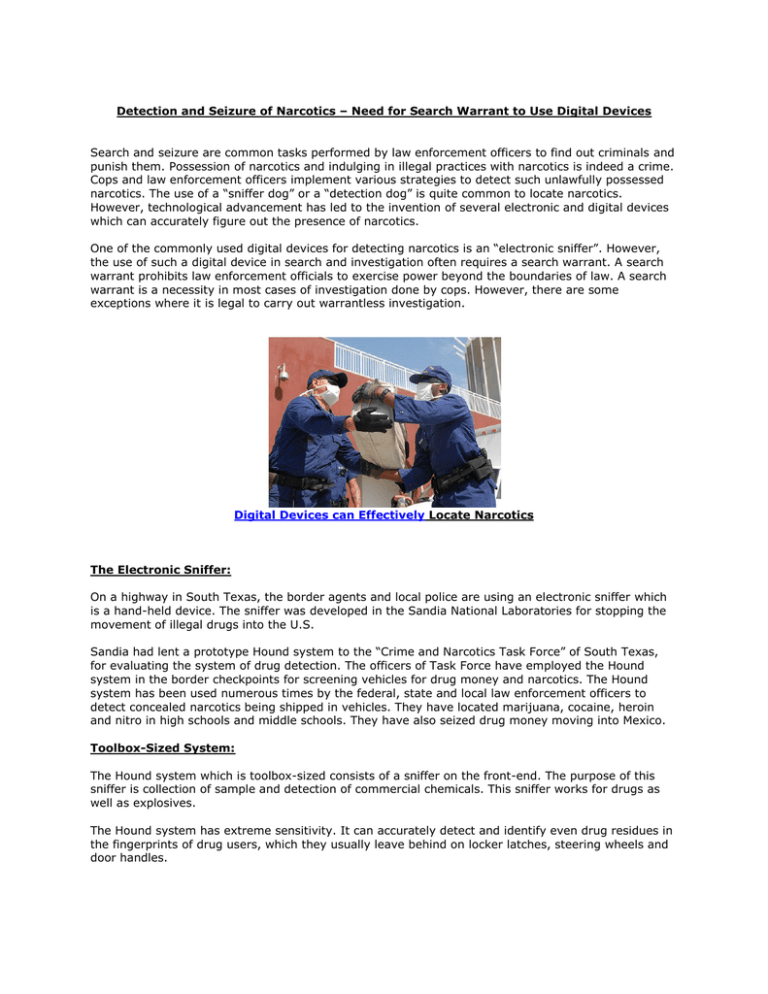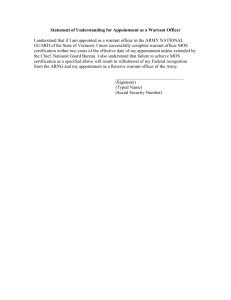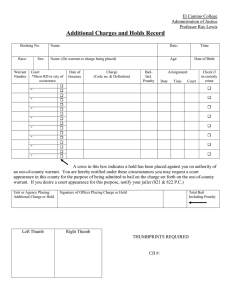this “guest post” by “proficient” writer Alisa Martin
advertisement

Detection and Seizure of Narcotics – Need for Search Warrant to Use Digital Devices Search and seizure are common tasks performed by law enforcement officers to find out criminals and punish them. Possession of narcotics and indulging in illegal practices with narcotics is indeed a crime. Cops and law enforcement officers implement various strategies to detect such unlawfully possessed narcotics. The use of a “sniffer dog” or a “detection dog” is quite common to locate narcotics. However, technological advancement has led to the invention of several electronic and digital devices which can accurately figure out the presence of narcotics. One of the commonly used digital devices for detecting narcotics is an “electronic sniffer”. However, the use of such a digital device in search and investigation often requires a search warrant. A search warrant prohibits law enforcement officials to exercise power beyond the boundaries of law. A search warrant is a necessity in most cases of investigation done by cops. However, there are some exceptions where it is legal to carry out warrantless investigation. Digital Devices can Effectively Locate Narcotics The Electronic Sniffer: On a highway in South Texas, the border agents and local police are using an electronic sniffer which is a hand-held device. The sniffer was developed in the Sandia National Laboratories for stopping the movement of illegal drugs into the U.S. Sandia had lent a prototype Hound system to the “Crime and Narcotics Task Force” of South Texas, for evaluating the system of drug detection. The officers of Task Force have employed the Hound system in the border checkpoints for screening vehicles for drug money and narcotics. The Hound system has been used numerous times by the federal, state and local law enforcement officers to detect concealed narcotics being shipped in vehicles. They have located marijuana, cocaine, heroin and nitro in high schools and middle schools. They have also seized drug money moving into Mexico. Toolbox-Sized System: The Hound system which is toolbox-sized consists of a sniffer on the front-end. The purpose of this sniffer is collection of sample and detection of commercial chemicals. This sniffer works for drugs as well as explosives. The Hound system has extreme sensitivity. It can accurately detect and identify even drug residues in the fingerprints of drug users, which they usually leave behind on locker latches, steering wheels and door handles. The tool has proved to be extremely useful for the U.S. Border Patrol officers in investigating and detecting suspicious items and vehicles. Using the tool has made the law enforcement officers the extent of drug problems arising almost every day in the areas surrounding the border. The Hound system is being improved further to suit better to drug detection applications. Requirement for a Search Warrant: Search warrant is basically a document approved judicially, which gives the authority to law enforcement officials to search and investigate a particular place. For obtaining a search warrant, a police officer needs to provide some information that supports an assumption that evidence of a crime is likely to be found in a specific place or places. The officer also needs to prepare a list of the specific places he or she wants to search and the illegal items likely to be found. The officer needs to guarantee that the information he or she has is true. The information is presented by the officer in an Affidavit, to a judge or magistrate. The judge or magistrate decides on whether the warrant should be approved or not. Investigation of places where narcotics are likely to be found may or not require a search warrant. In cases involving a search warrant, the cops must search only those places where the items mentioned in the search warrant are likely to be found. So, the officers should not disturb vehicles are not likely to be indulged in shipping of narcotics. Also, the items mentioned in the search warrant should only be seized, unless there is a strong evidence of other illegal items present or illegal activities being carried out. Various techniques of carrying out the search and investigation can be approved by the magistrates and judges. In such cases, the warrant needs to authorize the use of electronic devices and phone records for conducting the investigation and if needed, seizing the illegal items. So, when the law enforcement officers use a digital device like an electronic sniffer for the detecting narcotics, the use must be authorized by the warrant. Cases where a Search Warrant is not required: Usually, a search warrant is not a necessity in the event of a lawful arrest, search of impounded vehicles, border search, seizure of unlawful items that are visible clearly, and any search that needs to be conducted due to demanding circumstances. Administrative agencies are free to conduct searches without a warrant in highly regulated industries like food service and strip mining. It is also lawful to conduct a warrantless search where the presence of narcotics is strongly evident. In such case, the law enforcement officials can use digital devices to carry out the investigation. The narcotics found from such a search can be seized by the officers even in the absence of a warrant. State and federal laws also authorize warrantless random testing to detect the presence of drugs in the body of persons holding sensitive positions, like customer officials, railroad employees, drug interdiction officers and air traffic controllers. So, cops can carry out warrantless investigation to detect if a person has taken narcotics in any way in his body. Most of the cases of search and investigation involve a search warrant. The issue of a search warrant is subject to many conditions and the conditions vary from country-to-country. For example, the cops often avail legal services in Thailand to determine whether a case would involve a search warrant, since, the issue of a warrant in Thailand are subject to the country’s laws. The officers need to have a strong reason to issue a search warrant. The law asks for a compelling reason for issuing a warrant to protect the general public from arbitrary police intrusions. A warrant is issued only for justified searches. To protect the general public from unnecessary searches and investigation by cops, the Fourth Amendment had been designed, which is present in the constitution of U.S. The Fourth Amendment states that people own the right to be safe and secure in their houses along with their belongings, against unreasonable investigations, searches and seizures. This right must not be violated by law enforcement officers, and no search warrants would be issued, unless there is a probable cause. This probable cause should be supported by affirmation or Oath. Conclusion: The investigations for detection of narcotics can be effectively conducted with the help of digital devices. Such digital devices can accurately locate the presence of concealed drugs and narcotics too. However, the use of electronic devices may require the authorization of a search warrant in some cases. Author’s Bio: Alisa Martin is a proficient author writing quality articles on Law and other related themes.




